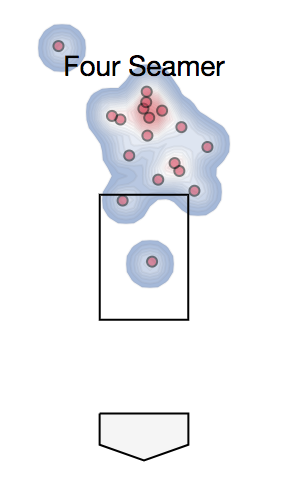The Cleveland Indians broke from Spring Training with a star-studded rotation – Corey Kluber, Carlos Carrasco, Trevor Bauer, Mike Clevinger, and Shane Bieber. If they were going to win the AL Central for a fourth consecutive season, the arms were going to carry them to the finish line. Those expectations went south quickly. Yes, Bieber has been nothing short of amazing. Early on, however, Clevinger and Kluber hit the IL. An unfortunate leukemia diagnosis for Carrasco has kept him away from baseball. Bauer was traded at the deadline for much needed offensive help, further depleting an already ravaged rotation.
Luckily for Cleveland, there were pitchers to replace those voids. None has been more impressive than Aaron Civale. The early report on Civale? A pitcher with good command and below-average velocity. He certainly bucks the trend of the modern starter yet somehow continues to dominate as exemplified by a 2.35 ERA and 0.91 WHIP in five starts this month. As Civale looks to pitch the Indians into favorable playoff position, let’s see what has made him successful so far.
The Arsenal
Despite the aforementioned middling velocity, Civale definitely fits in the modern game with his spin-centric repertoire. Comparing their Bauer Unit (BU) to that of the league average, we see the following:
| Pitch | Usage | pVal | Spin Rate | MPH | Bauer Unit | League Avg. Bauer Unit |
| SI | 35.3% | 5.7 | 2259 | 92.7 | 24.37 | 23.16 |
| FC | 32.1% | 3.3 | 2643 | 88 | 30.03 | 26.62 |
| SL | 12.9% | 2.0 | 2784 | 83.7 | 33.26 | 28.66 |
| CU | 8.2% | -1.1 | 2917 | 75.8 | 38.48 | 32.23 |
| CH | 8.0% | 0.7 | 2065 | 84.1 | 24.55 | 21.41 |
| FA | 3.4% | -0.4 | 2431 | 92.3 | 26.34 | 24.48 |
Civale has a higher BU than the league average on every single pitch. For the four-seamer and the breaking pitches, consider it a positive. For his sinker and changeup, however, it means the ball is not dropping as much as the league average, therefore it’s not an ideal combination to have.
Civale’s most thrown pitch is the sinker. While the pitch doesn’t exactly sink, it has great arm side run.
Civale has generally run the sinker on the edges, particularly to the glove side. This pitch works particularly well freezing left-handed hitters, as shown above, or making the right-handed hitter give up on that pitch given how far off it starts off the plate.
However, given the exceptional horizontal movement, it is an incredibly difficult pitch to locate. Against left-handed hitters, if the ball leaks towards the middle of the plate, then it gets hammered. Against right-handed hitters, the location becomes even tougher, where if the ball does not end up far enough inside or exactly on the outside corner, then it’s an even easier pitch to hit since the ball is coming into the hitter. So far, Civale has done a fairly nice job locating it and thus the reason he throws the sinker as much as he does with good results.
Civale also throws a cutter, at nearly the same rate as his sinker, so you know he has confidence in the pitch.
The cutter is deployed to complement to the sinker. Both pitches yield weak contact. While the cutter results in a far greater number of swings and misses – the latter resulting in a 13.3 SwStr% compared to the former’s 2.1%.
Of his most frequent pitches, the last is the slider.
The pitch has some nice depth and break at a good velocity, but only has a 6.8 SwStr%, so there’s no real swing and miss on the pitch.
Next, we’ve got the changeup.
Of all his pitches, the changeup is elite, registering 18.8 SwStr%. Given the exceptional depth on the pitch, derived from great hand position while turning the ball over, the results are fairly self-explanatory.
Civale’s four-seamer has rarely been thrown. Notably, throwing a grand total of zero last Wednesday against the Detroit Tigers.
In the few that have been thrown, we can see that he does not have a great feel for the pitch, being waste pitches far above the zone. The importance of this pitch is tied entirely to the usage of the curveball.
What a sight. It’s got an incredible downward break on a slight tilt, making for remarkable movement on a single pitch. Unfortunately, the pVal on the pitch is -1.1 – below average. What attributes to that undesirable statistic is a fascinating debate?
Profit Maximization
To date, Civale’s been an absolute godsend for the Cleveland Indians. There will certainly be a book on him at some point. That could be this season or entering next season. If he wants to continue to keep his spot in the rotation, it seems that he will have to make some changes.
Civale’s splits against lefties and righties perfectly sum up his issues. Even though he’s been elite against both so far, there are some discrepancies in performance.
| sOPS+ | K% | BB% | |
| LHB | 22 | 32.1% | 1.9% |
| RHB | 61 | 14.9% | 5.7% |
Notice the difference between the two. Looking at that table, there is no question that Civale has been far better against left-handed hitters than against right-handed hitters. Let’s see how he attacks both hitters.
| LHB | RHB | |
| SI | 29.6% | 39.4% |
| FC | 35.9% | 29.5% |
| SL | 4.0% | 19.2% |
| CU | 8.1% | 8.3% |
| CH | 17.5% | 1.3% |
| FA | 4.9% | 2.2% |
This is a really odd table. He throws his sinker more to right-handed hitters than the counterpart. For a pitch that clearly has more effectiveness against left-handed hitters, it’s used as a front-door pitch, it really does not make sense to have such a contrary usage. Though if you notice, he uses his two highest swing and miss pitches at a high rate against lefties, the cutter and changeup, ergo explaining his demonstrable success.
As we theorize here, let’s see how Civale could improve against right-handed hitters. For starters, dropping the sinker usage would be ideal. Using more cutters, since it goes away from the hitter and will likely be a tougher pitch to hit, would be an additional improvement. In addition, the slider should be dropped in favor of more curveballs. The curveball not only has incredible depth but has a slight tilt away from the right-handed hitter to boot.
However, with increased usage, there will need to be a pitch that Civale uses at the top of the zone to effectively tunnel the curveball. If he were to use the curveball without really operating at the top of the zone now, you could theoretically know what’s coming when the pitch starts up. This is where using the four-seamer would be particularly useful, and the previously shown Bauer Unit of the pitch (26.34), shows that it would be effective if it’s located at the top of the zone. If Civale is able to start using his four-seamer and curveball more, he would be able to add another dimension to his arsenal, going North and South in the strike zone, rather than just operating East and West – using the sinker and slider as he currently operates. By being able to operate in all parts of zone, you’ll start to see his strikeout ability exponentially increase – definitely more than his current 7.36 K/9.
Conclusion
Aaron Civale has cemented himself in the Cleveland rotation this season. It’s exactly what the Indians were expecting when they drafted him in the third round of the 2016 MLB Draft. Though as Cleveland’s elite starters return next season, Civale’s place in the rotation is uncertain going forward. If Civale is able to have success through the rest of the season, Kluber could be made expendable as Cleveland continues to lower the payroll. As we start looking towards 2020, Civale’s performance down the stretch could ultimately alter the baseball landscape.
(Photo by Frank Jansky/Icon Sportswire)



2020 rotation: Kluber, Carrasco, Clevinger, Bieber… Salazar? Fighting for spots: Civale, Plesac… Plutko and Allen (and McKenzie (ace potential) coming back from injury)? Is that about right? How much do you think they can count on Kluber and especially Carrasco and Salazar being healthy most of next season? I ask because Civale seems like the kind of pitcher that could be very effective over the long-term if given the chance (but, I also think Plesac could be a quality work-horse type – thoughts on him?). Thanks
Outside of Salazar, I believe you’ve got all the right players in there – at this point, it’s difficult to trust him to be healthy. I completely agree with you on Civale and he should have the inside track for the final spot next season given his performance so far. For Kluber, I think health shouldn’t be a great concern going forward but he does have two team options (20-21) going forward at 17.5 and 18 M a year, respectively, so I’m not sure if Cleveland is willing to foot that bill – it depends on what they think of their back end options and Carrasco’s health (if the Indians feel uncertain about his health going forward, I think they’ll just keep Kluber). Even though I love Plesac’s ability to locate, his SIERA is above 5 with a .243 BABIP, so the future returns might be ugly. However, I don’t think Allen or Plutko have inspired a ton of confidence either at this point, given both also have SIERA’s over 5 – of the three I do like Plesac the most right now though Allen might have the best stuff and therefore the highest ceiling going forward. Unfortunately, I do not know much about McKenzie, but he’s only reached AA to this point and it just seems unlikely he leapfrogs the other options to get a rotation spot.
Thanks Jai